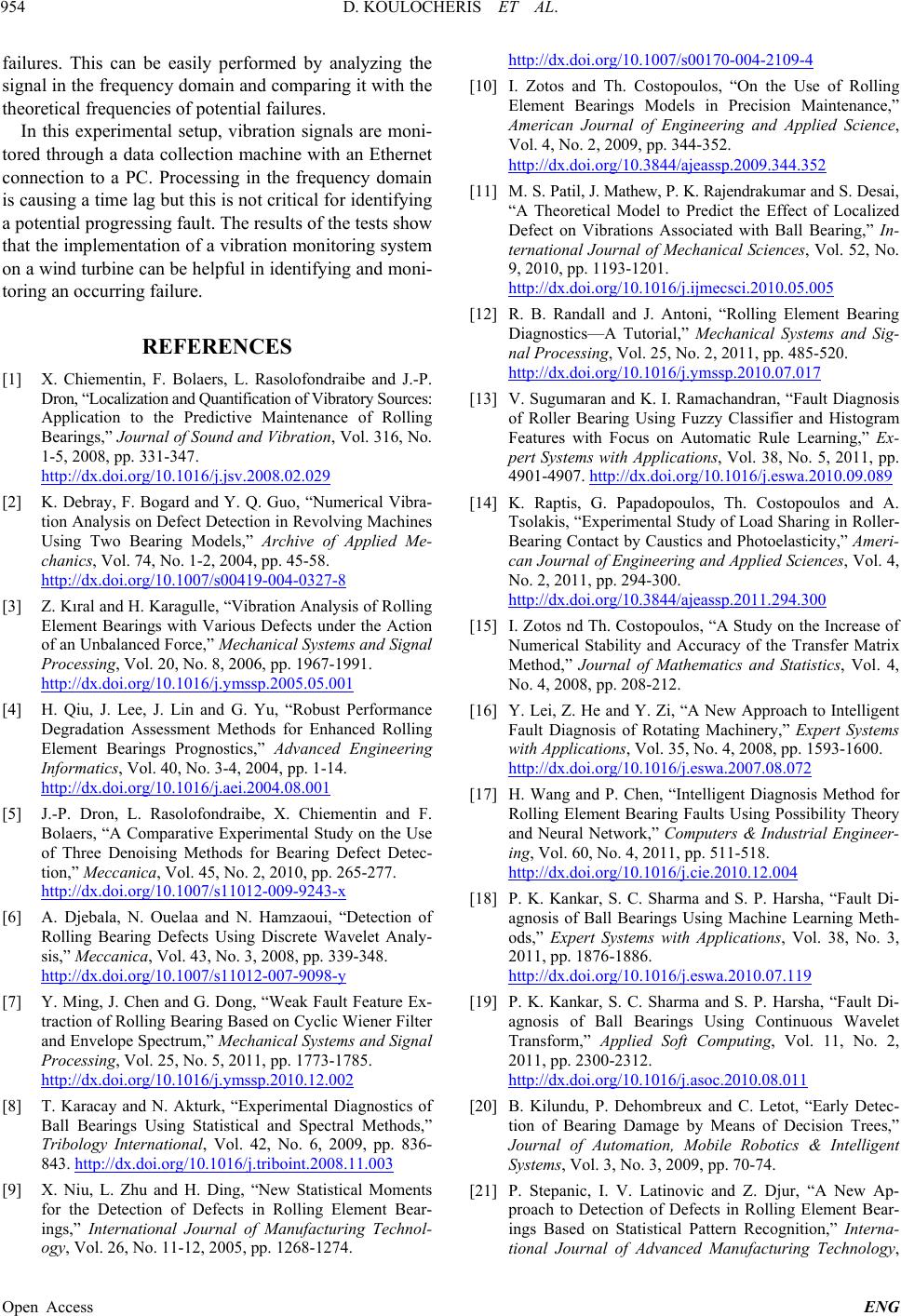
D. KOULOCHERIS ET AL.
954
failures. This can be easily performed by analyzing the
signal in the frequency domain and comparing it with the
theoretical frequencies of potential failures.
In this experimental setup, vibration signals are moni-
tored through a data collectio n machine with an Ethernet
connection to a PC. Processing in the frequency domain
is causing a time lag but this is not critical for identifying
a potential progressing fault. The results of the tests show
that the implementation of a vibration monitoring system
on a wind turbine can be helpfu l in identifying and moni-
toring an occurring failure.
REFERENCES
[1] X. Chiementin, F. Bolaers, L. Rasolofondraibe and J.-P.
Dron, “Localization and Q uantification of V ibrator y Sources :
Application to the Predictive Maintenance of Rolling
Bearings,” Journal of Sound and Vibration, Vol. 316, No.
1-5, 2008, pp. 331-347.
http://dx.doi.org/10.1016/j.jsv.2008.02.029
[2] K. Debray, F. Bogard and Y. Q. Guo, “Numerical Vibra-
tion Analysis on Defect Detection in Revolving Machines
Using Two Bearing Models,” Archive of Applied Me-
chanics, Vol. 74, No. 1-2, 2004, pp. 45-58.
http://dx.doi.org/10.1007/s00419-004-0327-8
[3] Z. Kıral and H. Karagulle, “Vibration Analysis of Rolling
Element Bearings with Various Defects under the Action
of an Unbalanced Force,” Mechanical Systems and Signal
Processing, Vol. 20, No. 8, 2006, pp. 1967-1991.
http://dx.doi.org/10.1016/j.ymssp.2005.05.001
[4] H. Qiu, J. Lee, J. Lin and G. Yu, “Robust Performance
Degradation Assessment Methods for Enhanced Rolling
Element Bearings Prognostics,” Advanced Engineering
Informatics, Vol. 40, No. 3-4, 2004, pp. 1-14.
http://dx.doi.org/10.1016/j.aei.2004.08.001
[5] J.-P. Dron, L. Rasolofondraibe, X. Chiementin and F.
Bolaers, “A Comparative Experimental Study on the Use
of Three Denoising Methods for Bearing Defect Detec-
tion,” Meccanica, Vol. 45, No. 2, 2010, pp. 265-277.
http://dx.doi.org/10.1007/s11012-009-9243-x
[6] A. Djebala, N. Ouelaa and N. Hamzaoui, “Detection of
Rolling Bearing Defects Using Discrete Wavelet Analy-
sis,” Meccanica, Vol. 43, No. 3, 2008, pp. 339-348.
http://dx.doi.org/10.1007/s11012-007-9098-y
[7] Y. Ming, J. Chen and G. Dong, “Weak Fault Feature Ex-
traction of Rolling Bearing Based on Cyclic Wiener Filter
and Envelope Spectrum,” Mechanical Systems and Signal
Processing, Vol. 25, No. 5, 2011, pp. 1773-1785.
http://dx.doi.org/10.1016/j.ymssp.2010.12.002
[8] T. Karacay and N. Akturk, “Experimental Diagnostics of
Ball Bearings Using Statistical and Spectral Methods,”
Tribology International, Vol. 42, No. 6, 2009, pp. 836-
843. http://dx.doi.org/10.1016/j.triboint.2008.11.003
[9] X. Niu, L. Zhu and H. Ding, “New Statistical Moments
for the Detection of Defects in Rolling Element Bear-
ings,” International Journal of Manufacturing Technol-
ogy, Vol. 26, No. 11-12, 2005, pp. 1268-1274.
http://dx.doi.org/10.1007/s00170-004-2109-4
[10] I. Zotos and Th. Costopoulos, “On the Use of Rolling
Element Bearings Models in Precision Maintenance,”
American Journal of Engineering and Applied Science,
Vol. 4, No. 2, 2009, pp. 344-352.
http://dx.doi.org/10.3844/ajeassp.2009.344.352
[11] M. S. Patil, J. Mathew, P. K. Rajendrakumar and S. Desai,
“A Theoretical Model to Predict the Effect of Localized
Defect on Vibrations Associated with Ball Bearing,” In-
ternational Journal of Mechanical Sciences, Vol. 52, No.
9, 2010, pp. 1193-1201.
http://dx.doi.org/10.1016/j.ijmecsci.2010.05.005
[12] R. B. Randall and J. Antoni, “Rolling Element Bearing
Diagnostics—A Tutorial,” Mechanical Systems and Sig-
nal Processing, Vol. 25, No. 2, 2011, pp. 485-520.
http://dx.doi.org/10.1016/j.ymssp.2010.07.017
[13] V. Sugumaran and K. I. Ramachandran, “Fault Diagnosis
of Roller Bearing Using Fuzzy Classifier and Histogram
Features with Focus on Automatic Rule Learning,” Ex-
pert Systems with Applications, Vol. 38, No. 5, 2011, pp.
4901-4907. http://dx.doi.org/10.1016/j.eswa.2010.09.089
[14] K. Raptis, G. Papadopoulos, Th. Costopoulos and A.
Tsolakis, “Experimental Study of Load Sharing in Roller-
Bearing Contact by Caustics and Photoelasticity,” Ameri-
can Journal of Engineering and Applied Sciences, Vol. 4,
No. 2, 2011, pp. 294-300.
http://dx.doi.org/10.3844/ajeassp.2011.294.300
[15] I. Zotos nd Th. Costopoulos, “A Study on the Increase of
Numerical Stability and Accuracy of the Transfer Matrix
Method,” Journal of Mathematics and Statistics, Vol. 4,
No. 4, 2008, pp. 208-212.
[16] Y. Lei, Z. He and Y. Zi, “A New Approach to Intelligent
Fault Diagnosis of Rotating Machinery,” Expert Systems
with Applications, Vol. 35, No. 4, 2008, pp. 1593-1600.
http://dx.doi.org/10.1016/j.eswa.2007.08.072
[17] H. Wang and P. Chen, “Intelligent Diagnosis Method for
Rolling Element Bearing Faults Using Possibility Theory
and Neural Network,” Computers & Industrial Engineer-
ing, Vol. 60, No. 4, 2011, pp. 511-518.
http://dx.doi.org/10.1016/j.cie.2010.12.004
[18] P. K. Kankar, S. C. Sharma and S. P. Harsha, “Fault Di-
agnosis of Ball Bearings Using Machine Learning Meth-
ods,” Expert Systems with Applications, Vol. 38, No. 3,
2011, pp. 1876-1886.
http://dx.doi.org/10.1016/j.eswa.2010.07.119
[19] P. K. Kankar, S. C. Sharma and S. P. Harsha, “Fault Di-
agnosis of Ball Bearings Using Continuous Wavelet
Transform,” Applied Soft Computing, Vol. 11, No. 2,
2011, pp. 2300-2312.
http://dx.doi.org/10.1016/j.asoc.2010.08.011
[20] B. Kilundu, P. Dehombreux and C. Letot, “Early Detec-
tion of Bearing Damage by Means of Decision Trees,”
Journal of Automation, Mobile Robotics & Intelligent
Systems, Vol. 3, No. 3, 2009, pp. 70-74.
[21] P. Stepanic, I. V. Latinovic and Z. Djur, “A New Ap-
proach to Detection of Defects in Rolling Element Bear-
ings Based on Statistical Pattern Recognition,” Interna-
tional Journal of Advanced Manufacturing Technology,
Open Access ENG